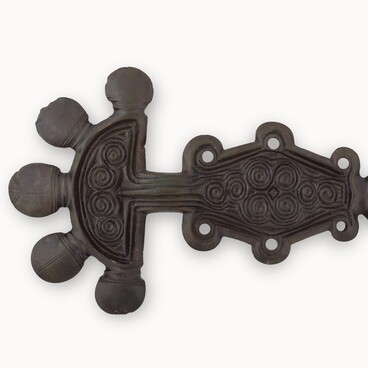The Kursk Regional Museum of Archaeology houses a clay lamp of the 3rd century. Antique lamps are very interesting finds: not only can they be clearly dated, but also they make it possible to identify the nature of the external economic relations of the region where they were found. These lamps were mostly made of clay.
The lamp was found near the village of Tazovo, Zolotukhinsky district of the Kursk region during the archaeological exploration of Oleg Alexandrovich Radyush, a researcher of the Institute of Archaeology of the Russian Academy of Sciences. The item has a rounded shape with a slightly concave bottom. The handle of the vessel at the time of finding was broken off. The horn protrudes forward, the spout is short and slightly rounded. The discus is separated from the shoulders by two carved grooves. The discus itself is wide and has a concave shape.
Its entire surface is covered with a relief scene: a clearly identifiable figure of an adult and the other, poorly visible one. The clay is of orange shade after firing. Analyzing the relief ornament, which is depicted on the discus, experts offer several options for its interpretation. The art historian Oscar Ferdinandovich Valdgauer, who published an article about a similar lamp from the Hermitage collection, interpreted the scene as follows: “Satyr (?) with a hide thrown over his arm beats a cupid; behind him is a tree.” According to the opinion of Denis Valerievich Zhuravlev, who holds a PhD in History, the scene depicts an entirely different motif, a popular one in the Roman art: Aeneas flees Troy carrying his elderly father Anchises on his shoulders and leading his young son Ascanius by the hand. This scene is not only known from the discuses of Roman lamps, but also from fresco paintings. For example, it is depicted on a famous fresco from Pompeii, which is kept in the National Museum of Naples.
The lamp was used in the following way: a wick made of moss or wool was inserted into the spout. The inner volume of the vessel was filled with melted fat or oil. Pulling the wick outward or dipping it inward, it was possible to regulate the required size of the flame. The lamp found near the village of Tazovo bears evidence of the lively trade linking the eastern Roman provinces in the 3rd century with the peoples of the Chernyakhov archaeological culture, which had a polyethnic composition (the eastern Venets and Antes, Sarmatians, Dacians, Getians, Thracians, late Scythians, Goths and Gepids), living in the territory of the modern Kursk region.
The lamp was found near the village of Tazovo, Zolotukhinsky district of the Kursk region during the archaeological exploration of Oleg Alexandrovich Radyush, a researcher of the Institute of Archaeology of the Russian Academy of Sciences. The item has a rounded shape with a slightly concave bottom. The handle of the vessel at the time of finding was broken off. The horn protrudes forward, the spout is short and slightly rounded. The discus is separated from the shoulders by two carved grooves. The discus itself is wide and has a concave shape.
Its entire surface is covered with a relief scene: a clearly identifiable figure of an adult and the other, poorly visible one. The clay is of orange shade after firing. Analyzing the relief ornament, which is depicted on the discus, experts offer several options for its interpretation. The art historian Oscar Ferdinandovich Valdgauer, who published an article about a similar lamp from the Hermitage collection, interpreted the scene as follows: “Satyr (?) with a hide thrown over his arm beats a cupid; behind him is a tree.” According to the opinion of Denis Valerievich Zhuravlev, who holds a PhD in History, the scene depicts an entirely different motif, a popular one in the Roman art: Aeneas flees Troy carrying his elderly father Anchises on his shoulders and leading his young son Ascanius by the hand. This scene is not only known from the discuses of Roman lamps, but also from fresco paintings. For example, it is depicted on a famous fresco from Pompeii, which is kept in the National Museum of Naples.
The lamp was used in the following way: a wick made of moss or wool was inserted into the spout. The inner volume of the vessel was filled with melted fat or oil. Pulling the wick outward or dipping it inward, it was possible to regulate the required size of the flame. The lamp found near the village of Tazovo bears evidence of the lively trade linking the eastern Roman provinces in the 3rd century with the peoples of the Chernyakhov archaeological culture, which had a polyethnic composition (the eastern Venets and Antes, Sarmatians, Dacians, Getians, Thracians, late Scythians, Goths and Gepids), living in the territory of the modern Kursk region.



